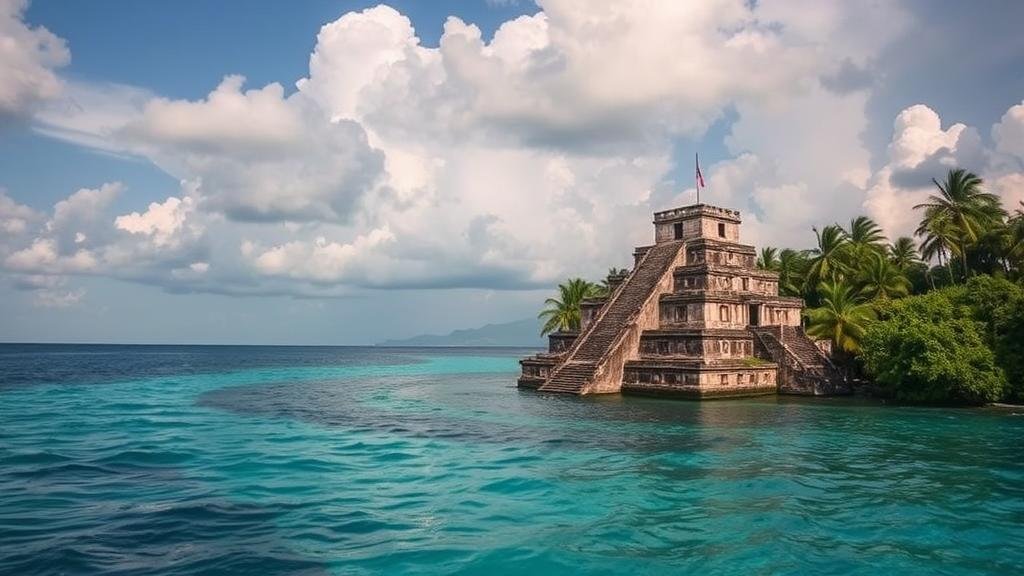Tracing Mayan legends to locate rumored underwater shrines in the Caribbean Sea.
Tracing Mayan Legends to Locate Rumored Underwater Shrines in the Caribbean Sea
The Caribbean Sea, renowned for its stunning beaches and crystal-clear waters, holds a treasure trove of history and mythology beneath its surface. Among such legends are those of the ancient Maya civilization, known for their advanced knowledge of astronomy, mathematics, and architecture. This article delves into the fascinating quest of tracing Mayan legends to locate rumored underwater shrines, exploring the intersection of folklore and archaeology in this enchanting region.
The Rich Tapestry of Mayan Mythology
The Maya, who flourished from approximately 2000 BCE to the arrival of Europeans in the 16th century, created a complex pantheon of gods and myths. Central to their belief system were deities associated with water and fertility, such as Chaac, the rain god, and Ix Chel, the goddess of the moon and medicine. Many legends describe sacred sites that are believed to have been submerged during periods of drought or natural disasters.
Perhaps the most compelling of these tales is that of the lost city of Atlántida, often tied to the legendary Atlantis. Although primarily a product of European imagination, some scholars speculate that it could stem from ancient Mayan accounts of cities swallowed by the sea, aligning with coastal areas like the Yucatán Peninsula, particularly around Tulum and Akumal.
Historical Context and Evidence
Archaeological evidence suggests that the Maya were skilled navigators of the Caribbean Sea, engaging in trade and cultural exchange with other Mesoamerican civilizations. Artifacts recovered from coastal archaeological sites like Kankirixche, Belize, reveal interactions with seafaring cultures, hinting at shared myths and religious practices.
In recent years, underwater explorations have uncovered submerged structures near the coast of the Yucatán Peninsula, leading many to consider the possibility that these might be remnants of ancient Mayan shrines. For example, in 2000, divers discovered a series of stone formations near the same region, speculated to align with sacred Mayan astronomical practices.
Underwater Archaeology: A Modern Pursuit
Modern technology has transformed underwater archaeology, allowing researchers to explore areas previously inaccessible. Techniques such as sonar mapping and remotely operated vehicles (ROVs) have revealed extensive underwater landscapes that may hide remnants of Mayan civilization.
- Sonar Mapping: This technology provides a detailed visualization of the sea floor, unveiling potential structures that warrant further investigation.
- ROVs: Equipped with high-definition cameras, these devices allow archaeologists to examine submerged sites and document findings in real-time.
Research conducted by the Global Underwater Explorer (GUE) in locations like the cenotes of Mexico has resulted in significant discoveries, including items believed to have been offerings to the gods, buried in these watery landscapes.
Prominent Sites for Exploration
Several regions in the Caribbean Sea are particularly famous for their connections to Mayan legends and reported underwater shrines:
- The cenotes of Tulum: These natural sinkholes were often considered sacred by the Maya and may house submerged relics.
- The waters off Cozumel: Frequently mentioned in Mayan texts and believed to be the home of Ix Chel, Cozumel presents opportunities for discovery.
- Lake Xolotlan: Although landlocked, legends reference this lake as an ancient site of worship, where rituals honoring water deities were performed.
A Journey Through Time: Real-World Applications
The search for underwater Mayan shrines serves multiple purposes. On an archaeological level, it allows for a deeper understanding of Mayan culture and religion. But, modern tourism and conservation efforts also spring from these explorations. Eco-tourism opportunities arise from these discoveries, attracting visitors eager to experience the legends and experience firsthand the beauty of underwater archaeology.
Also, ongoing research fuels international collaboration among archaeologists, historians, and local communities, promoting cultural preservation in the face of environmental threats such as climate change and sea-level rise.
Takeaways for Explorers
For those interested in joining the quest for Mayan underwater shrines, consider the following actionable steps:
- Engage in local archaeological programs: Many organizations welcome volunteers for underwater excavations and research projects.
- Stay informed: Follow updates on archaeological discoveries in the region to gain insights into emerging findings and locations.
- Respect local customs: Embrace the cultural heritage of the Maya by being respectful during visits to sacred sites and local communities.
By tracing Mayan legends, we venture into a realm where history, myth, and underwater mysteries intertwine, offering glimpses of a civilization that continues to fascinate and inspire generations.



